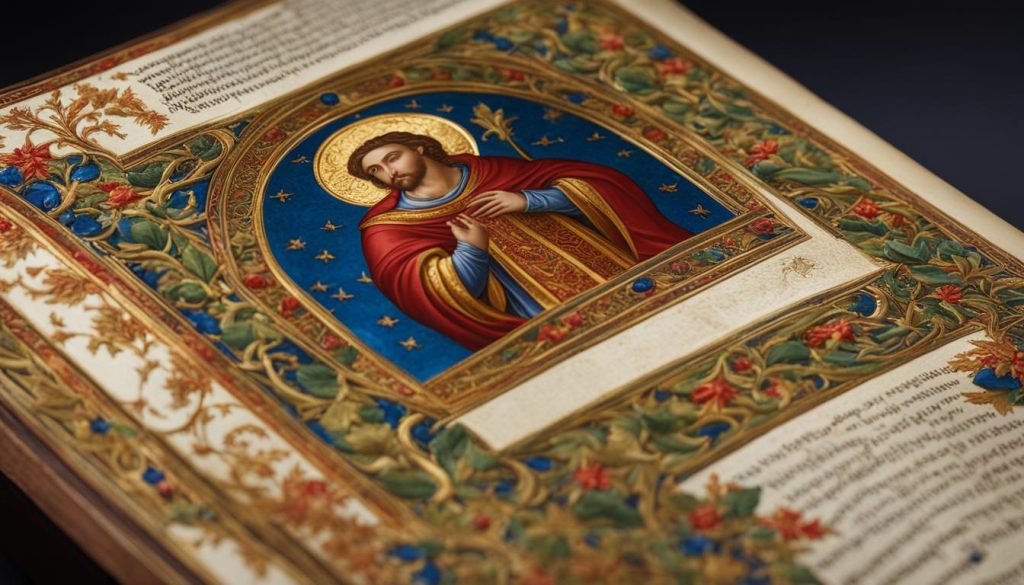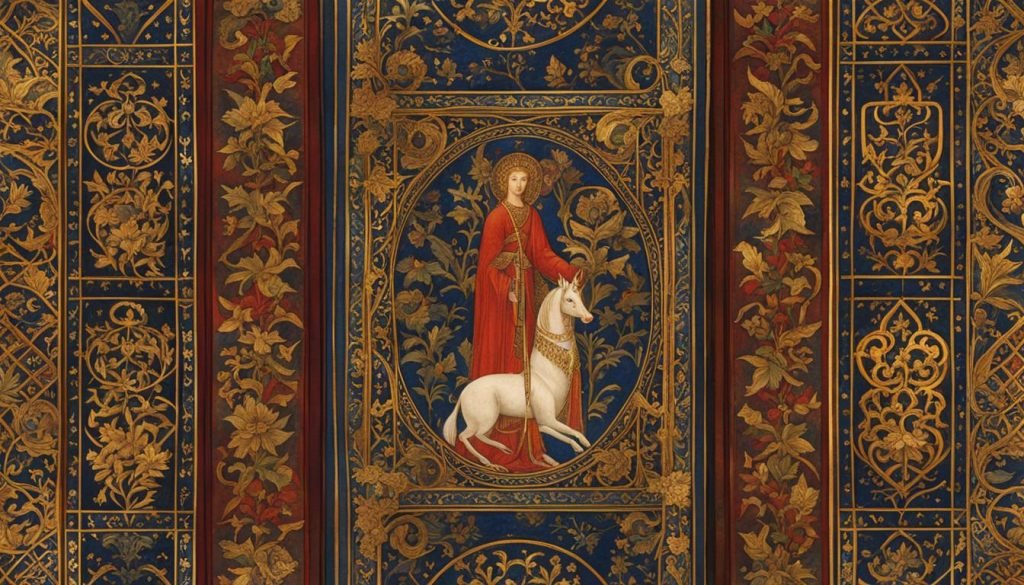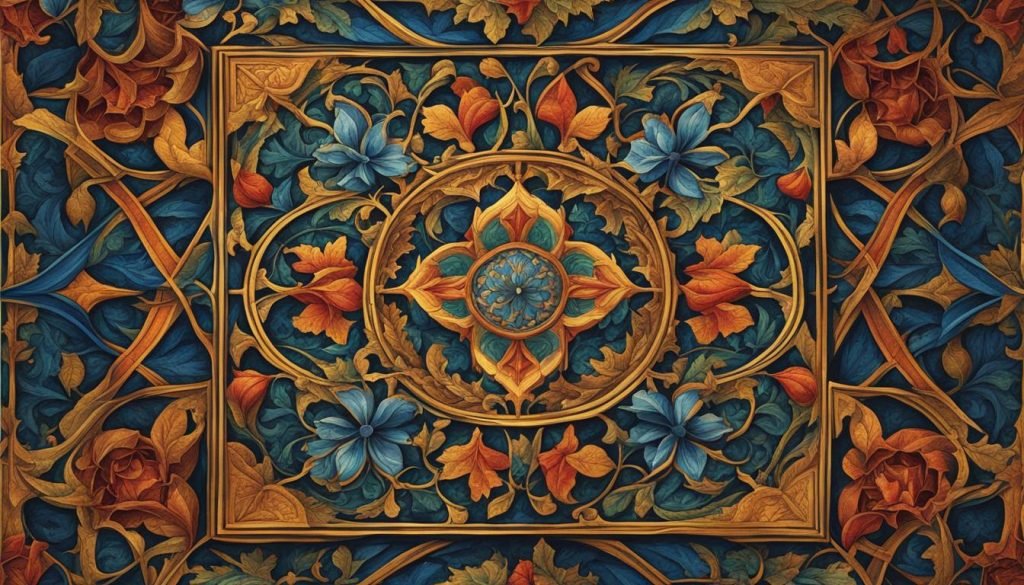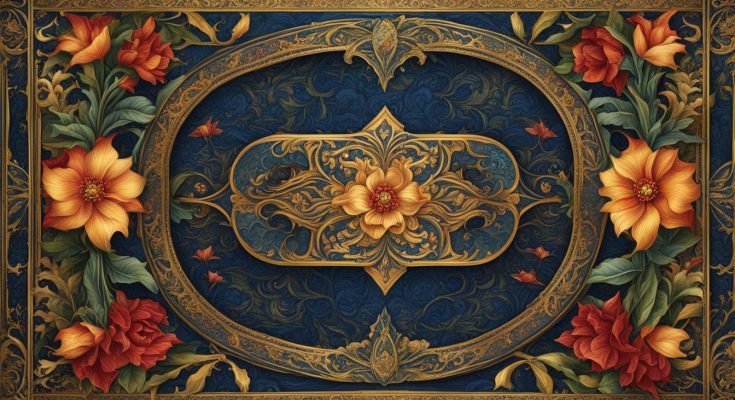Illuminated Manuscript Techniques: Discover the Secrets of Medieval Art Revival
Welcome to the fascinating world of illuminated manuscript art. In this article, we will explore the techniques and craftsmanship behind these exquisite medieval works of art. Whether you are an art enthusiast or simply curious about the rich history of illuminated manuscripts, you are in for a treat. Let’s delve into the captivating world of illuminated manuscript techniques and discover how they continue to inspire artists today.
Key Takeaways:
- Illuminated manuscripts are a form of medieval art known for their artistry and religious devotion.
- They were crafted by monks in monastic scriptoria before the invention of printing.
- The tradition of illuminated manuscripts started with the Irish school and continued with Charlemagne’s and the German Ottonian school.
- These manuscripts came in various types, including ceremonial books, Gospel Books, treatises, and secular books.
- European book painting styles evolved from Romanesque to Gothic, with the invention of the printing press marking the decline of manuscript illumination.
Historical Background of Illuminated Manuscripts

The tradition of illuminated manuscripts dates back to the early medieval period, with the emergence of notable schools of art. The Irish school, which flourished around 600 AD, was known for its intricate and decorative coloring techniques influenced by Byzantine art. Later, Charlemagne’s school at Aachen in the 8th and 9th centuries and the German Ottonian school in the 10th and 11th centuries further developed the art of illuminated manuscripts.
The Irish school produced iconic masterpieces like the Book of Kells, which showcased elaborate interlacing patterns and vibrant colors. Charlemagne’s school focused on creating manuscripts for liturgical purposes, displaying large, bold letters and architectural elements. The German Ottonian school introduced naturalistic elements and exhibited exceptional skills in miniature painting.
These schools played a crucial role in the evolution of illuminated manuscripts, bringing together influences from various regions and artistic traditions. Their dedication to craftsmanship and devotion to religious art laid the foundation for the flourishing of illuminated manuscripts in the medieval period.
The Influence of Byzantine Art
Byzantine art greatly influenced the development of illuminated manuscripts. The use of gold leaf, vibrant colors, and intricate embellishments were borrowed from Byzantine art traditions. The techniques of depicting figures and drapery, as well as the sense of spirituality infused into the artwork, were also inspired by Byzantine art. The influence of Byzantine art can be seen in the delicate and detailed illuminations of these manuscripts.
How Illuminated Books Came to be Made
In the medieval period, illuminated books were meticulously crafted by monks in monastic scriptoria. These scriptoria were designated areas within monasteries where the monks would laboriously create these ornate manuscripts. The manuscripts served a dual purpose – as religious art and acts of devotion. The monks dedicated countless hours to the delicate and intricate process of illuminating these books, showcasing their skill and dedication to their faith.
Originally, the production of illuminated manuscripts was solely a religious endeavor, with monks creating these manuscripts for use within the monastic community. However, as time went on, the demand for illuminated books expanded beyond religious circles. Knights and noblemen began commissioning these elaborate manuscripts for personal use, such as prayer books and private collections. This shift in patronage led to the emergence of guilds of illuminators, transforming the creation of illuminated manuscripts into a commercial enterprise.
The creation of these manuscripts involved several stages. First, the parchment or vellum sheets were prepared by scraping and treating animal skins. Then, the text was carefully transcribed by hand using ink made from various natural materials. The illuminators, skilled in their craft, would then embellish the pages with vibrant and detailed decorations, using gold leaf, bright pigments, and intricate designs. The final result was a work of art that combined calligraphy, illustration, and decoration, serving as a testament to the skill and devotion of the artists who created them.
Examples of Illuminated Manuscripts from Monastic Scriptoria
| Manuscript | Origin | Highlights |
|---|---|---|
| Book of Kells | Ireland | Elaborate Celtic designs, intricate calligraphy |
| Godescalc Evangelistary | Aachen, Charlemagne’s school | Byzantine-influenced coloring, vibrant illustrations |
These examples showcase the exquisite craftsmanship and artistic skill that went into creating illuminated manuscripts in monastic scriptoria. The intricate designs, vibrant colors, and meticulous attention to detail continue to captivate art enthusiasts and scholars to this day.
Types of Manuscripts: From Ceremonial Books to Secular Works
The art of illuminated manuscripts encompassed a wide range of manuscripts, serving various purposes and capturing the diverse interests of medieval society. These manuscripts can be categorized into four main types: ceremonial books, Gospel Books, treatises for theological instruction, and secular works.
Ceremonial Books: These manuscripts were lavish and ornate, often adorned with jewelry, precious metals, and intricate decorations. They were used in religious ceremonies, such as the celebration of Mass or the coronation of royalty. Ceremonial books were considered precious objects, reflecting both the spiritual and temporal importance of the events they were associated with.
Gospel Books: The Gospel Books, also known as Evangeliaries, were dedicated to the four Gospels of the New Testament. These manuscripts were used during church services and held great significance in religious worship. Gospel Books featured beautifully illuminated pages, carefully crafted letters, and intricate illustrations depicting scenes from the life of Christ and other biblical narratives.
Treatises for Theological Instruction: Manuscripts dedicated to theological instruction played a vital role in the education and dissemination of religious knowledge. These treatises contained scholarly texts, commentaries, and interpretations of religious doctrines. Illuminators often illustrated these manuscripts with depictions of biblical figures, theological concepts, and allegorical scenes to aid understanding and engage the reader.
Secular Works: As the demand for illuminated manuscripts grew beyond ecclesiastical circles, secular works emerged as a fashionable trend during the 14th and 15th centuries. These manuscripts encompassed a wide range of subjects, including romances, histories, poetry, and scientific texts. Illuminators drew inspiration from the secular interests of the time, creating stunning illustrations that captured the spirit of the era.
| Type of Manuscript | Description |
|---|---|
| Ceremonial Books | Lavish and ornate manuscripts used in religious ceremonies and important events. |
| Gospel Books | Dedicated to the four Gospels of the New Testament, used in church services. |
| Treatises for Theological Instruction | Manuscripts containing scholarly texts and commentaries on religious doctrines. |
| Secular Works | Manuscripts on various secular subjects, reflecting the interests of the time. |
“The variety of illuminated manuscripts illustrates the richness and diversity of medieval society. From the grandeur of ceremonial books to the intellectual pursuit of theological treatises, these manuscripts offer us a glimpse into the intricate tapestry of medieval life and culture.”
By exploring the different types of manuscripts, we can gain a deeper understanding of the artistic, religious, and intellectual landscape of the Middle Ages. Each type of manuscript serves as a testament to the creativity, craftsmanship, and cultural significance of illuminated manuscripts as both religious artifacts and works of art.
Five Centuries of European Book Painting

The period from approximately 1000 to 1500 witnessed the evolution of European book painting styles. During this time, two prominent styles emerged: the Romanesque style and the Gothic style. These distinct artistic movements showcased different approaches to color, composition, and representation, leaving a lasting impact on the world of art.
The Romanesque style, prevalent until the mid-12th century, prioritized narrative clarity over optical veracity. Artists emphasized bold, flat colors and stylized forms to convey religious stories and symbolism. Manuscripts illuminated in the Romanesque style often featured intricate decorative borders and elongated figures, creating a sense of otherworldliness.
As the Gothic style gained popularity in the 12th century, book painting took a more realistic turn. Artists like Simone Martini pushed the boundaries of miniature representation, using delicate brushwork and attention to detail to create lifelike figures and landscapes. Gothic manuscripts featured vibrant colors, flowing lines, and ornate embellishments, reflecting the growing aesthetic sensibilities of the time.
| Features | Romanesque Style | Gothic Style |
|---|---|---|
| Color Palette | Vibrant, bold colors | Rich, vibrant colors |
| Composition | Flat, stylized forms | Detailed, lifelike figures |
| Ornamentation | Intricate decorative borders | Ornate embellishments |
With the invention of the printing press in the 15th century, the demand for illuminated manuscripts declined. However, the rich artistic legacy of European book painting continues to inspire artists and enthusiasts to this day, serving as a testament to the enduring power of medieval art.
Key Takeaways:
- The Romanesque style, prevalent until the mid-12th century, emphasized narrative clarity and stylized forms.
- The Gothic style, emerging in the 12th century, focused on lifelike representation and ornate embellishments.
- Both styles left a lasting impact on European art and continue to inspire artists today.
Early Medieval Art in Europe

The Early Middle Ages witnessed the emergence of various artistic styles and periods in Europe, each reflecting the historical, religious, and cultural developments of different regions. From migration period art to Byzantine, Insular, Carolingian, Ottonian, Romanesque, and Gothic art, these diverse styles shaped the artistic landscape of the time.
The migration period art, also known as the “Barbarian art,” emerged in the aftermath of the fall of the Western Roman Empire. It encompassed the artistic expressions of the Germanic, Celtic, and Slavic peoples who migrated and settled across Europe. Notable examples include the Migration period fibulae and the Sutton Hoo burial treasures.
The Byzantine art, influenced by the Byzantine Empire, encompassed the rich artistic traditions of the Eastern Mediterranean. It emphasized religious themes, intricate mosaics, and iconic representations. The masterpiece of Byzantine art is the Hagia Sophia in Constantinople (present-day Istanbul).
The Insular art, also known as Hiberno-Saxon art, flourished in the British Isles and Ireland. It drew inspiration from Celtic and Germanic traditions, featuring intricate interlacing patterns, intricate metalwork, and illuminated manuscripts such as the Book of Kells.
| Period | Artistic Style | Key Features and Examples |
|---|---|---|
| Carolingian Art | Carolingian Renaissance | Revival of Roman and Greek influences, illuminated manuscripts like the Utrecht Psalter |
| Ottonian Art | Ottonian Renaissance | Abbey of Saint Gall illuminated manuscripts, the Quedlinburg Itala fragment |
| Romanesque Art | Romanesque style | Massive architecture, rounded arches, frescoes, illuminated manuscripts like the Winchester Bible |
| Gothic Art | Gothic style | Pointed arches, ribbed vaults, stained glass windows, sculptures like the Reims Cathedral |
The Carolingian art, characterized by the Carolingian Renaissance, saw a revival of Roman and Greek influences under the rule of Charlemagne. The era produced illuminated manuscripts such as the Utrecht Psalter and the Lindisfarne Gospels, reflecting a blend of classical and Christian themes.
The Ottonian art, also known as the Ottonian Renaissance, developed under the rule of the Ottonian dynasty in Germany. Noteworthy examples include illuminated manuscripts from the Abbey of Saint Gall and the Quedlinburg Itala fragment.
The Romanesque art, prevalent from the 11th to the 13th centuries, featured massive architecture with rounded arches, frescoes, and illuminated manuscripts like the Winchester Bible.
The Gothic art, which emerged in the 12th century, introduced pointed arches, ribbed vaults, and stained glass windows, transforming the architectural landscape of Europe. Iconic examples include the Reims Cathedral and the Chartres Cathedral.
Artistic Legacy of Middle Ages Europe

Art history is filled with periods and movements that have shaped and influenced artistic expression throughout the ages. One notable period that continues to leave its mark on the world of art is the Middle Ages in Europe. This era, characterized by its rich religious symbolism and intricate craftsmanship, has inspired countless artists throughout history.
European Revivalism and Modernism are two movements that have drawn inspiration from the art of the Middle Ages. European Revivalism sought to revive the artistic styles and techniques of the past, including those found in medieval art. Artists like Edgar Miller embraced the craftsmanship and attention to detail seen in illuminated manuscripts and other medieval works. They incorporated these elements into their own designs, creating a unique fusion of the old and the new.
Modernism, on the other hand, challenged traditional artistic conventions and embraced new forms of expression. Despite its departure from traditional modes of art, Modernism drew inspiration from diverse sources, including the Middle Ages. The design aesthetics of medieval art, with its emphasis on balance, harmony, and intricate patterns, resonated with Modernist artists who sought to create visually engaging and thought-provoking works.
Incorporating elements of medieval art into contemporary designs allowed artists like Edgar Miller to create unique and captivating works. By blending the art history of the Middle Ages with their own artistic vision, these artists have left a lasting legacy that continues to inspire and influence artists today.
Edgar Miller’s Stained Glass Work
Edgar Miller, a renowned artist influenced by Gothic paint techniques and Modernism, made significant contributions to the field of stained glass design. His remarkable talent for blending traditional Gothic techniques with modern design elements resulted in breathtaking works of art that continue to captivate audiences to this day.
Miller’s stained glass pieces showcased his mastery of intricate details and intricate craftsmanship. His careful selection of vibrant colors and skillful manipulation of light allowed him to create stunning visual effects within the medium of stained glass. Each piece told a story, infusing intimacy and modernity into the traditional medium.
The combination of Gothic paint techniques and a modernist approach resulted in stained glass designs that were both visually striking and emotionally evocative. Miller’s ability to harmoniously merge the two styles demonstrated his deep understanding and appreciation for the art form’s historical roots while pushing boundaries and exploring new artistic possibilities.
Through his stained glass work, Edgar Miller left an indelible mark on the world of art. His unique blend of Gothic paint techniques, modernist design, and meticulous craftsmanship produced pieces that continue to inspire awe and admiration. Miller’s stained glass designs are a testament to the enduring beauty and timeless appeal of the Middle Ages, brought into the modern world through his visionary artistry.
Table: Notable Works of Edgar Miller’s Stained Glass
| Artwork Title | Description |
|---|---|
| Chapel of St. James | A stunning stained glass installation depicting biblical scenes and religious symbolism. |
| City Church of the Immaculate Conception | An intricate stained glass window depicting the life of the Virgin Mary. |
| Temple Beth Israel | A series of stained glass windows showcasing Jewish symbols and religious themes. |
Miller’s Mural Artwork
Edgar Miller’s artistic talent extended beyond stained glass work to include captivating mural artwork. Inspired by Medieval royal courts, Biblical stories, and allegorical vignettes, Miller’s murals brought the Middle Ages to life in a modern context. His narrative-driven approach filled these grand murals with action, depth, and diverse characters, reminiscent of epic tapestries of the past.
One of Miller’s notable mural pieces is “The Court of King Arthur,” which captures the legendary Arthurian realm in vivid detail. The mural depicts King Arthur and his knights in shining armor, engaged in their chivalrous pursuits. Surrounding them are scenes of courtly love, heroic quests, and mythical creatures. Miller’s attention to detail and his ability to create a sense of movement and energy make this mural a true masterpiece.
Another striking example of Miller’s mural work is “The Creation of the World.” This mural portrays biblical stories, starting with the creation of light and ending with the creation of Adam and Eve. Each panel showcases Miller’s skill in storytelling and his ability to capture the essence of these significant narratives. The vibrant colors, intricate details, and symbolic imagery make this mural a captivating visual representation of the biblical events.
| Mural Artwork | Description |
|---|---|
| The Court of King Arthur | A depiction of King Arthur and his knights engaged in courtly pursuits and heroic quests. |
| The Creation of the World | A portrayal of biblical stories, starting with the creation of light and ending with the creation of Adam and Eve. |
Miller’s mural artwork not only pays homage to the medieval period but also serves as a testament to his artistic vision and ability to bring historical and religious narratives to life through visual storytelling. His murals are immersive and transport viewers to a time of knights, kings, and divine creation, allowing them to experience the magic and beauty of the Middle Ages.
Miller’s Study of European Art
As an artist, Edgar Miller had a deep appreciation for European architecture and its influence on artistic design. He immersed himself in the study of the artisanship and motifs of the Middle Ages, particularly in woodblock carving. His exploration of European architecture allowed him to understand the intricate details and structural elements that made medieval buildings timeless.
Miller’s study of woodblock carving provided him with a unique perspective on negative space and reductive techniques. By mastering this art form, he was able to create bold and intricate designs that showcased a fusion of Modernist elements with medieval influences. His illustrations and designs were a testament to his ability to blend the old and the new, creating captivating works of art that captured the imagination.
Whether it was the soaring cathedrals of Europe or the delicate tracery found in medieval manuscripts, Miller drew inspiration from European architecture to bring a touch of the past into the present. His extensive knowledge of European art allowed him to create intricate and visually stunning pieces that celebrated the craftsmanship of the Middle Ages while embracing the boldness of Modernist designs.
Miller’s study of European architecture and woodblock carving laid the foundation for his unique artistic style. By incorporating elements from the Middle Ages into his work, he not only paid homage to the past but also created a bridge between different artistic eras. His ability to blend these influences seamlessly is what set his artwork apart and made him a true master of his craft.
FAQ
What are illuminated manuscripts?
Illuminated manuscripts are a form of medieval art that were crafted by monks before the invention of printing. They were highly valued for their artistry, craftsmanship, and religious devotion.
What were the schools that contributed to the tradition of illuminated manuscripts?
The Irish school, Charlemagne’s school at Aachen, and the German Ottonian school were influential in the development of illuminated manuscripts.
Who made illuminated manuscripts?
Monks in monastic scriptoria were responsible for creating illuminated manuscripts. Initially, they were made for religious purposes, but later, knights and noblemen commissioned them for personal use.
What types of illuminated manuscripts were there?
Illuminated manuscripts had various types, including ceremonial books, Gospel Books, treatises for theological instruction, and secular books.
How did European book painting styles evolve during the medieval period?
The Romanesque style prevailed until the mid-12th century and focused on narrative clarity. The Gothic style emerged later and emphasized more realistic depictions.
What were the different styles of early medieval art in Europe?
Early medieval art in Europe included migration period art, Byzantine art, Insular art, Carolingian art, Ottonian art, Romanesque art, and Gothic art.
How did Edgar Miller incorporate medieval influences into his art?
Edgar Miller drew inspiration from medieval European art and incorporated Gothic, Romanesque, Celtic, Hiberno-Saxon, and Germanic styles into his designs.
What was Edgar Miller known for in his stained glass work?
Edgar Miller showcased his mastery of Gothic paint techniques and blended them with Modernist design elements in his stained glass creations.
What subjects did Edgar Miller depict in his murals?
Edgar Miller’s murals depicted scenes reminiscent of Medieval royal courts, Biblical stories, and allegorical vignettes, bringing historical and religious narratives to life.
What aspects of European art did Edgar Miller study?
Edgar Miller extensively studied European architecture, focusing on the artisanship and design motifs of the Middle Ages. He also studied woodblock carving and incorporated these techniques into his own designs.




